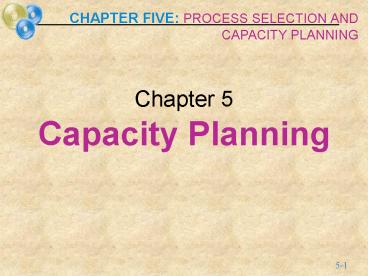Capacity Planning PowerPoint PPT Presentation
1 / 20
Title: Capacity Planning
1
Chapter 5
- Capacity Planning
2
Capacity Planning
- Capacity is the upper limit or ceiling on the
load that an operating unit can handle. - The basic capacity questions are
- What kind of capacity is needed?
- How much is needed?
- Bruce nuclear
- When is it needed?
- Banks may require you to adjust time line
What are the factors effecting our capacity of
BBA grads?
3
Capacity
- Design capacity
- maximum obtainable output
- Effective capacity
- Maximum capacity given product mix, scheduling
difficulties, and other doses of reality. - Reduced by operational controllable factors
- Scheduling, maintenance
- Actual output
- rate of output actually achieved--cannot exceed
effective capacity. - Reduced by uncontrollable factors
- Machine breakdown, absenteeism, material shortage
4
Efficiency and Utilization
Actual output Efficiency Effective
capacity Actual output Utilization
Design capacity
5
Efficiency/Utilization Example
- Design capacity 200 phones/day
- Effective capacity 180 phones/day
- Actual output 160 phones/day
- Actual output 160
units/day - Efficiency 89
- Effective capacity 180
units/ day - Utilization Actual output
160 units/day 80 - Design capacity
200 units/day
Iridium
Managers should try and get Utilization
Efficiency
6
Determinants of Effective Capacity
- Facilities
- Buildings, labour
- Products or services
- Standardize courses vs. customized curriculum
- Processes
- WWW, correspondence, distance ed., mass teaching
- Human considerations
- Skill level, course variety, driving distance,
mornings - Operations
- scheduling
- External forces
- Government funding, CA requirements, reputation
7
Developing Capacity Alternatives
- Design flexibility into systems
- Lay underground fiber, fast network wiring
- Point in the product life cycle
- Take a big picture approach to capacity
changes - New Faculty parking, other dept., enrollment
etc. - Prepare to deal with capacity chunks
- Caused by new building
- Attempt to smooth out capacity requirements
- Complementary products, teach in summer
- Capacity cushion needed?
- Determine optimal level
8
Class Exercise
- Your starting a business what capacity issues do
you have to deal with? What is your design and
effective capacities? How will you calculate
your efficiency and utilization?
9
Evaluating Alternatives
Production units have an optimal rate of output
for minimal cost.
Average cost per unit
Minimum cost
0
Rate of output
10
Evaluating Alternatives
Minimum cost optimal operating rate are
functions of size of production unit.
Small plant
Average cost per unit
Medium plant
Large plant
0
Output rate
11
Calculating Processing Requirements
A professor teaches 5 courses, average 40
students, 3 hours/week, 12 weeks per course, in a
year. How many professors does it take to meet
capacity requirements? (Ignore students in 3yr.
and elective courses)
12
Calculating Processing Requirements
- Our SBE department is considering implementing a
concurrent degree with the B.Ed. (i.e., get both
degrees in 5 years). It is expected that there
would be 35 new students if this option was
implemented. If a professor teaches either 4
(researching professor) or 6 (no research)
courses, how many new professors do we need?
Assume students take 5 courses per term and they
would be all in the same class. - Does the demand on resources change as they move
into 3rd and 4th year
PR4 10/42.5 thus, 3 professors PR610/6 1
2/3, thus 2 professors
13
Cost-Volume Relationships
14
Cost-Volume Relationships
15
Cost-Volume Relationships
Break even Quantity
16
Break-Even Problem with Step Fixed Costs
17
Break-Even Problem with Step Fixed Costs
18
Step wise costs What are the break even point(s)
- The university has the potential to hire the
following professors - Prof. type Salary courses
- 1 researcher 75,000 4
- 1 non-research 60,000 6
- 1 non-research 60,000 6
- Assume that in each course there are 20 students
for each research professor we have 20,000
overhead, 10,000 for a non-researching
professor there is a variable cost of 50 /
student / course and that a student pays tuition
of 440 which is matched (funded) by the
provincial government. - What are the break even point(s) in terms or of
students?
19
Solution
- QBE1(75k 20k)/(440x2-50) 114 students (no
BE) - QBE2(75k60k20k10k)/(440x2-50) 199 students
- QBE3(75k60k60k40k)/(440x2-50) 283 students
20
Financial Analysis
- Payback Crude, widely used method for
determining time until initial investment is
realized. Inv6000, PB1000, T6 - Cash Flow (CF) - the difference between cash
received from sales and other sources, and cash
outflow for labor, material, overhead, and taxes.
Student revenue Sept. provincial revenue end of
year professor salary montly. - Present Value (PV) - the sum, in current value,
of all future cash flows of an investment
proposal. - Internal rate of return (IRR) equivalent
interest rate based on future returns.

